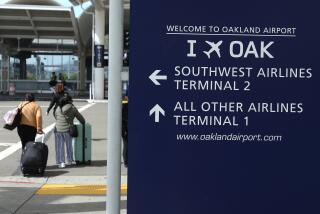What’s in a Name? In New York, It’s Often Confusion
- Share via
NEW YORK — “PanAmMetLife200ParkAve, please!”
That’s roughly what Bill Manfredi has mumbled to cabbies since the office building where he works changed its name from Pan Am to Met Life.
It’s just one more survival skill in a city where building names seem to change as fast as traffic lights, a city with two General Electric buildings, two AT&T; buildings, and now, two Metropolitan Life buildings.
Met Life No. 1, the corporate headquarters, is a 100-year-old skyscraper overlooking Madison Square.
Met Life No. 2, which used to be known as the Pan Am Building and is sometimes called 200 Park, is about a mile up Park Avenue. Met Life has owned the building since 1981, but decided last year that there was no point to having a building named after an airline that no longer flies.
So the huge Pan Am signs and logos came down, huge new MetLife signs and logos went up, and in January the latter were lit--causing an epidemic of double takes up and down Park Avenue.
And confusing some travelers.
“Get in a cab and just say ‘Met Life Building,’ and you could find yourself going downtown,” said Manfredi, whose employer, Matsui & Co., was an original Pan Am tenant.
“Everyone’s still calling it the Pan Am building,” he added. “I think everyone will always call it that.”
Barry Lewis, an architectural historian and guide, thinks he knows why.
“Corporations come and go, but changing a building’s name goes against the grain of people’s habits. People use a name to create an identity for a building. They get comfortable with it.”
Similar discomfort was caused after General Electric bought RCA and renamed its building in Rockefeller Center the GE building--not to be confused with the other GE building at Lexington and 51st. Which was originally named--yes--the RCA building.
In 1984, AT&T; moved its name and its corporate symbol, the statue known as “Golden Boy,” from 195 Broadway to a new skyscraper with the Chippendale top at Madison and 55th. Now AT&T; has sold that building to Sony and taken its headquarters and its statue to exurban New Jersey.
In three decades, a single edifice at Park Avenue and 59th Street has been the Pepsi-Cola building, the Olivetti building and now the Amro Bank building. Down the street, the Savoy Art Galleries became the Playboy Club became the Hongkong & Shanghai Bank.
There are several reasons why New York seems so changeable: It is the center of the volatile financial services industry, it attracts many foreign companies, and it has a lot of buildings--three times more office space than Chicago, seven times more than Boston, nine times more than Philadelphia.
Even the most august landmark usually has been through a few changes. Jay Shockley, a staffer at the Landmarks Preservation Commission, notes that “almost everything in our guide has had more than one name.”
Half the buildings in Rockefeller Center used to be named something else, including the Avenue of the Americas building (RKO), Simon & Schuster (U.S. Rubber) and 10 Rockefeller Plaza (Eastern Air Lines). The Warner Building used to be Esso, and 1 Rockefeller Plaza was Time-Life. Now, Time-Life is over on Sixth Avenue; so was Esso, which changed its name to Exxon before moving out of town.
For all the confusion, building name changes do chart the ebb and flow of commerce.
The New York Central Building was named after a railroad that eventually ran off the financial track. When it became the New York General Building, only two letters had to be changed on the signs outside. Now it is the Helmsley Building, after real estate baron Harry.
Familiar American names are being replaced by less familiar ones from overseas. No sooner had the E.F. Hutton tower been completed than the namesake brokerage house collapsed; 31 E. 52nd is now the Deutsche Bank building.
Corporate mortality often is marked by the replacement of a proper name with an address. The U.S. Lines Building became One Broadway, the Continental Illinois Center became 520 Madison, Standard Oil became 26 Broadway.
Hotels are notorious name changers. The Algonquin, ironically, once was the Puritan. Curmudgeonly publishing executives still say, “I’m staying at the Barclay,” oblivious to the fact the place on East 48th has been the Intercontinental for at least a decade.
But for sheer persistence, nothing can compete with the confusion over the two Palace hotels--one on Madison Avenue, where rooms start at $195 a night, and the other on the Bowery, which charges $6 a night.
Edward Hogan, manager of the latter, said the uptown Palace accommodated his complaints when it opened in 1980 by tacking “Helmsley” onto the beginning of its name (which, naturally, since has changed to the “New York Palace”).
“We still get their calls,” Hogan groused. “What’cha gonna do?”
More to Read
Inside the business of entertainment
The Wide Shot brings you news, analysis and insights on everything from streaming wars to production — and what it all means for the future.
You may occasionally receive promotional content from the Los Angeles Times.










